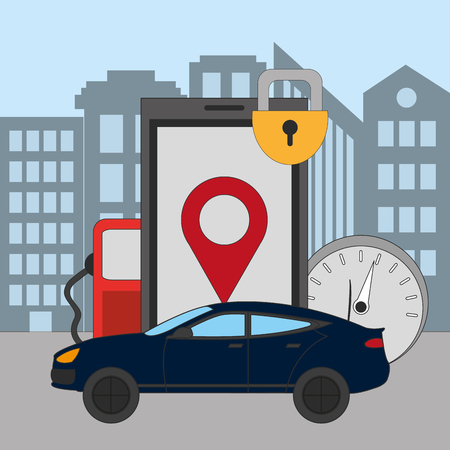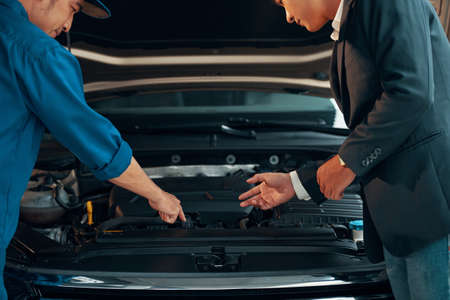1. Introduction to Emergency Brakes
The emergency brake, also known as the parking brake or handbrake, is a crucial safety feature in your vehicle. While many drivers rarely use it in daily driving, it plays an essential role in keeping your car stationary when parked and as a backup braking system in emergencies. Understanding how it works and why it needs regular testing and adjustment can help ensure your safety on the road.
What Is an Emergency Brake?
An emergency brake is a secondary braking system that operates independently of your vehicles main hydraulic brake system. It is designed to hold the vehicle in place when parked or act as a last resort in case of brake failure. Depending on your cars make and model, the emergency brake may be a hand lever, foot pedal, or electronic switch.
How Does the Emergency Brake Work?
The emergency brake engages a set of cables connected to the rear brakes. When activated, these cables apply pressure to the brake pads or shoes, preventing the wheels from moving. The table below summarizes the different types of emergency brakes and how they function:
| Type of Emergency Brake | How It Works |
|---|---|
| Hand Lever | Operated by pulling a lever usually located between the front seats. |
| Foot Pedal | Engaged by pressing a pedal typically found near the drivers left foot. |
| Electronic Brake | Activated by pressing a button; uses an electric motor to engage the brakes. |
Why Regular Testing and Adjustment Is Important
Over time, emergency brakes can loosen or become less effective due to cable stretching, wear, or rust. Regular testing ensures that the brake is functioning correctly, and adjustments help maintain optimal braking force. Ignoring emergency brake maintenance can lead to issues such as:
- The brake not holding the vehicle properly when parked.
- Difficulty engaging or disengaging the brake.
- Increased stopping distance in emergencies.
How Often Should You Check Your Emergency Brake?
A good rule of thumb is to test your emergency brake at least once a month. If you notice signs of reduced effectiveness, such as excessive play in the lever or pedal or the brake not holding as well as it should, its time for an adjustment or possible repair.
2. How to Test Your Emergency Brake
Testing your emergency brake (also called a parking brake) regularly is crucial to ensure it functions correctly when you need it most. Follow these step-by-step instructions to check if your emergency brake is working properly.
Step 1: Find a Safe Testing Area
To test your emergency brake, find a flat, open space with no traffic. A level parking lot or an empty driveway works well.
Step 2: Engage and Release the Brake
With your vehicle in park (or in gear if you drive a manual), engage the emergency brake fully. Then, release it. If the brake handle or pedal feels loose or doesn’t provide resistance, it may need adjustment.
Step 3: Test on a Flat Surface
While on a level surface:
- Engage the emergency brake.
- Shift the vehicle into neutral.
- Slowly release the foot brake.
If the car stays in place, the emergency brake is holding. If it rolls, the brake may not be functioning properly.
Step 4: Test on an Incline
Find a gentle slope or hill to check the brakes effectiveness under more stress.
- Park the car on the incline.
- Engage the emergency brake.
- Shift into neutral and slowly lift your foot off the brake pedal.
If the car holds steady, the brake is working. If it starts to roll, it likely needs adjustment.
Step 5: Test Rolling Resistance
Another way to test the emergency brake is by slightly engaging it while moving at low speed (about 5 mph). Gently pull the brake handle or press the brake pedal and see if the vehicle slows down. If it doesn’t provide noticeable resistance, it may need adjustment.
Step 6: Compare Brake Holding Strength
To better understand how well your emergency brake holds, use the table below for reference:
| Test Condition | Expected Result |
|---|---|
| Flat Surface | Car should not roll when brake is engaged |
| Incline | Car should stay in place without rolling |
| Slow Rolling Resistance | Brake should gradually slow the vehicle |
If your emergency brake fails any of these tests, it’s time for an adjustment. In the next section, we’ll cover how to properly adjust your emergency brake for better performance.

3. Signs Your Emergency Brake Needs Adjustment
Your emergency brake, also known as the parking brake, is critical for keeping your vehicle secure when parked and providing backup braking power in an emergency. However, over time, it can lose effectiveness. Here are some common signs that your emergency brake needs adjustment:
Excessive Lever Travel
One of the most noticeable signs of an improperly adjusted emergency brake is excessive lever or pedal travel. If you have to pull the handbrake lever too high or press the foot brake too far before it engages, the brake cable may be too loose.
How to Check:
- Engage the parking brake and count how many clicks the lever makes.
- Most vehicles should engage fully within 4 to 7 clicks.
- If the lever requires excessive effort or moves too far, an adjustment is needed.
Weak Brake Hold
If your car rolls when the emergency brake is engaged, its a clear sign that the brake isnt holding properly. This can be dangerous, especially on inclined surfaces.
How to Test:
- Park your car on a gentle slope.
- Engage the emergency brake fully.
- If the car moves or struggles to stay in place, the brake may need tightening.
Unusual Noises When Engaging or Releasing
Grinding, rubbing, or squeaking sounds while applying or releasing the emergency brake can indicate issues such as worn components, rust buildup, or cable misalignment.
Possible Causes:
| Noise | Possible Issue |
|---|---|
| Grinding | Worn brake shoes or pads |
| Squeaking | Rust buildup on brake components |
| Clicking | Loose or damaged brake cable |
Maintenance Tip
Keeping the emergency brake mechanism clean and well-lubricated can prevent excessive wear and reduce unusual noises.
4. How to Adjust Your Emergency Brake
Proper adjustment of your emergency brake is essential for ensuring maximum effectiveness. Whether your vehicle has a cable-operated or electronic emergency brake, following the right steps will help keep it in optimal condition. Below is a detailed guide on how to adjust both types, the tools you’ll need, and key precautions.
Tools Needed
- Jack and jack stands
- Lug wrench
- Screwdrivers
- Socket set and ratchet
- Wrench set
- Brake adjustment tool (if required)
- Flashlight
- Protective gloves
Adjusting a Cable-Operated Emergency Brake
Most older and manually adjusted emergency brakes are cable-operated. Over time, the cable may stretch or loosen, leading to reduced performance. Follow these steps to adjust it properly:
Step 1: Raise the Vehicle
- Park the car on a level surface and ensure it is in park (automatic) or in gear (manual).
- Use a jack to lift the rear of the car and secure it with jack stands.
- Remove the rear wheels if necessary to access the adjustment mechanism.
Step 2: Locate the Adjustment Mechanism
- Depending on your vehicle, the adjuster may be found:
- Underneath the car near the center console
- Behind the rear wheels on the brake assembly
- Inside the cabin, near the emergency brake lever or pedal
Step 3: Tighten or Loosen the Cable
Use the following table to identify and perform the appropriate adjustment:
| Issue | Adjustment |
|---|---|
| Emergency brake lever pulls too high or too many clicks | Tighten the adjustment nut to decrease slack |
| Brakes drag or do not release fully | Loosen the adjustment nut to provide more slack |
Turn the adjustment nut slowly and test the lever or pedal between adjustments to ensure the brake engages and releases correctly.
Adjusting an Electronic Emergency Brake
Many modern vehicles use an electronic parking brake (EPB) that requires special steps for adjustment. These units typically adjust automatically, but manual intervention may be needed in some cases.
Step 1: Engage Service Mode
- Consult your vehicle’s manual to enter maintenance or service mode.
- This often involves pressing the brake pedal and holding a button or using a diagnostic tool.
Step 2: Manually Adjust the Calipers
- Once in service mode, you may need to slightly rotate the adjustment screw on the caliper.
- Check for signs of excessive tightness or slack.
Step 3: Recalibrate the System
- Exit the service mode following the manufacturer’s instructions.
- Cycle the emergency brake on and off a few times to allow the system to adjust properly.
- Test the brake to ensure it holds the vehicle securely.
Precautions to Keep in Mind
- Always follow your vehicle’s manual for specific adjustment procedures.
- Ensure your vehicle is securely supported before working underneath it.
- Do not overtighten the emergency brake, as it can cause premature brake wear.
- For electronic systems, use proper diagnostic tools to avoid system malfunctions.
By following these steps, you can ensure your emergency brake functions properly, providing reliable stopping power in emergency situations. Regular inspection and adjustment will help maintain its effectiveness over time.
5. Five. Maintenance Tips for Long-Term Emergency Brake Performance
Keeping your emergency brake in top condition ensures reliability when you need it most. Regular maintenance helps prevent wear and tear, ensuring that your parking brake remains effective over time. Here are some best practices to maintain your emergency brake:
Lubricate Moving Parts
Proper lubrication prevents rust and ensures smooth operation. Over time, moisture and dirt can cause components to seize up, reducing brake effectiveness.
How to Lubricate Your Emergency Brake:
- Use a high-quality grease or lubricant recommended for brake systems.
- Apply lubricant to the lever mechanism, cable connections, and pivot points.
- Avoid excessive lubrication near brake pads or rotors to prevent contamination.
Inspect the Brake Cables
The emergency brake relies on cables to engage and disengage the brake system. Over time, cables can stretch, fray, or become corroded.
Signs of Cable Issues:
| Issue | Possible Cause | Solution |
|---|---|---|
| Loose or slack cable | Natural wear and stretching | Adjust or replace the cable |
| Frayed cable | Rust or deterioration | Replace the cable immediately |
| Brake does not fully engage | Obstruction or misalignment | Inspect and remove blockages |
Perform Periodic Adjustments
Over time, the emergency brake may lose tension due to wear, affecting performance. Adjusting the brake ensures it engages properly when needed.
Steps to Adjust Your Emergency Brake:
- Engage and disengage the brake several times to check for responsiveness.
- If the brake feels loose, locate the adjustment mechanism (usually found near the handle or rear wheels).
- Turn the adjustment screw or nut slightly to tighten the cable.
- Test the brake again to ensure it holds the vehicle securely.
Check and Clean Brake Components
Dirt, debris, and rust can build up over time, affecting brake performance. Regular inspections and cleaning help maintain optimal functionality.
Cleaning Tips:
- Remove dust and debris from the brake assembly using a brush or compressed air.
- Check for rust on rotors or drums and remove it with a wire brush if necessary.
- Ensure all bolts and brackets are secure and free of corrosion.
Test Your Emergency Brake Regularly
A simple test every few weeks ensures your emergency brake is functioning properly. Find a safe, level spot, engage the brake, and see if the vehicle holds in place.
Emergency Brake Testing Reminder:
- Test your brake on an incline to confirm it holds the vehicle.
- If you notice any unusual sounds or weak engagement, inspect cables and adjust tension.
- Schedule professional maintenance if necessary.
By following these maintenance steps, you can keep your emergency brake in excellent working condition, ensuring maximum safety and effectiveness when needed.


